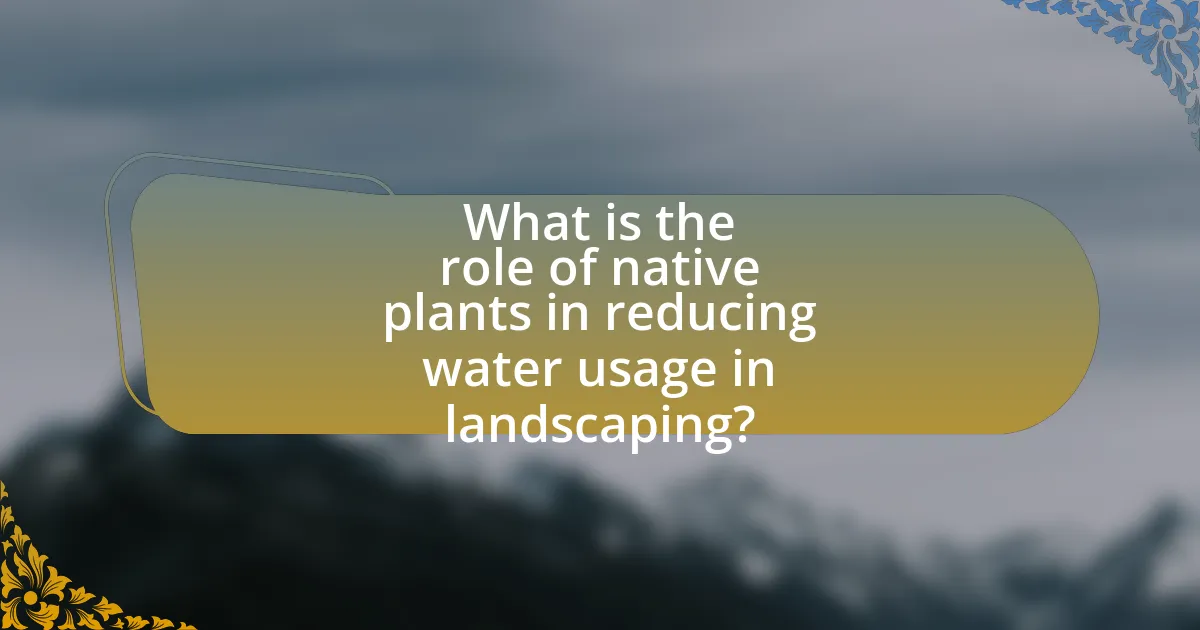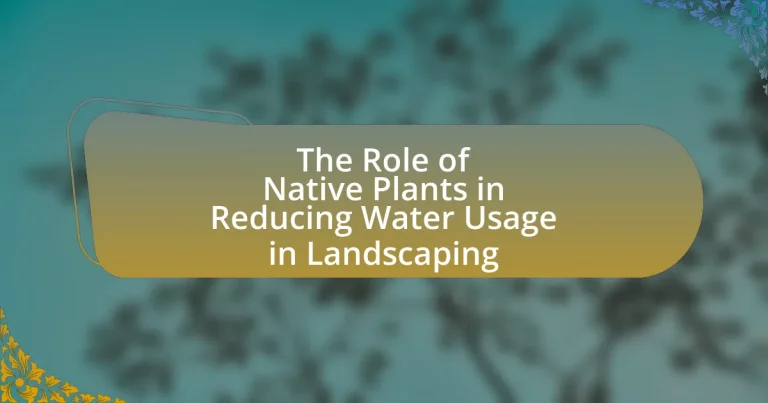Native plants are essential in reducing water usage in landscaping due to their adaptation to local climates and soil conditions, which minimizes the need for supplemental irrigation. This article explores how native plants, with their deep root systems and various adaptations, can decrease water consumption by up to 50% compared to non-native species. It discusses the environmental benefits of using native plants, including enhanced biodiversity, improved soil health, and reduced maintenance costs. Additionally, the article provides practical tips for homeowners on selecting and maintaining native plants to maximize water conservation in landscaping.

What is the role of native plants in reducing water usage in landscaping?
Native plants play a crucial role in reducing water usage in landscaping by being well-adapted to local climates and soil conditions, which minimizes the need for supplemental irrigation. These plants typically have deep root systems that allow them to access moisture from deeper soil layers, making them more drought-resistant compared to non-native species. Research indicates that landscapes featuring native plants can reduce water consumption by up to 50% compared to traditional landscaping practices that rely on non-native plants requiring more water. This efficiency not only conserves water resources but also promotes biodiversity and supports local ecosystems.
How do native plants differ from non-native plants in terms of water requirements?
Native plants generally require less water than non-native plants due to their adaptation to local climates and soil conditions. This adaptation allows native plants to thrive with minimal irrigation, as they have evolved to utilize local rainfall efficiently. In contrast, non-native plants often require more water to establish and maintain growth because they may not be suited to the local environment, leading to higher water consumption. Studies indicate that landscapes featuring native plants can reduce water usage by up to 50% compared to those dominated by non-native species, highlighting the efficiency of native plants in water conservation.
What adaptations do native plants have that help them conserve water?
Native plants have several adaptations that help them conserve water, including deep root systems, waxy leaf coatings, and reduced leaf surface area. Deep root systems allow these plants to access moisture from deeper soil layers, which is crucial in arid environments. Waxy leaf coatings minimize water loss by reducing transpiration, while smaller leaf surface areas decrease the amount of water lost to evaporation. These adaptations are essential for survival in their native habitats, where water availability can be limited.
How do soil types affect the water needs of native plants?
Soil types significantly influence the water needs of native plants by affecting water retention and drainage properties. Sandy soils, for instance, drain quickly and require more frequent watering, while clay soils retain moisture longer, reducing the need for irrigation. Research indicates that native plants adapted to specific soil types can optimize their water usage; for example, plants in loamy soils often thrive with less water due to balanced drainage and retention capabilities. This relationship underscores the importance of matching native plants to their appropriate soil types to enhance water efficiency in landscaping.
Why is water conservation important in landscaping?
Water conservation is important in landscaping because it helps to maintain sustainable ecosystems and reduces the demand on local water supplies. Efficient water use in landscaping minimizes waste and promotes the health of plants, particularly in arid regions where water scarcity is a significant concern. Studies indicate that landscapes designed with water-efficient practices can reduce water usage by up to 50%, thereby conserving vital resources and lowering utility costs for homeowners. Additionally, implementing water conservation strategies in landscaping can enhance soil health and reduce runoff, which contributes to better water quality in surrounding environments.
What are the environmental impacts of excessive water usage in landscaping?
Excessive water usage in landscaping leads to significant environmental impacts, including depletion of local water resources and increased runoff that can cause erosion and water pollution. When landscaping consumes more water than is sustainable, it can lower groundwater levels, affecting ecosystems and biodiversity. For instance, studies indicate that over-irrigation can contribute to nutrient leaching, which contaminates nearby water bodies with fertilizers and pesticides, harming aquatic life. Additionally, excessive water use can create an imbalance in local hydrology, leading to habitat loss for native species that rely on specific moisture conditions.
How does water conservation contribute to sustainable landscaping practices?
Water conservation significantly enhances sustainable landscaping practices by reducing the demand for irrigation and promoting the use of drought-resistant native plants. Native plants are adapted to local climates and require less water, which minimizes the need for supplemental irrigation. According to the U.S. Environmental Protection Agency, landscapes that incorporate native plants can reduce water usage by up to 50% compared to traditional landscaping. This reduction in water consumption not only conserves a vital resource but also decreases the energy required for water transport and treatment, further contributing to environmental sustainability.

What are the benefits of using native plants in landscaping?
Using native plants in landscaping offers significant benefits, particularly in reducing water usage. Native plants are adapted to local climate conditions and soil types, which means they require less irrigation compared to non-native species. Research indicates that native plants can reduce water consumption by up to 50% in landscaping applications, as they are more resilient to drought and can thrive on natural rainfall. Additionally, native plants support local ecosystems by providing habitat for wildlife and promoting biodiversity, which further enhances the sustainability of landscaping practices.
How do native plants enhance biodiversity in landscaping?
Native plants enhance biodiversity in landscaping by providing habitat and food sources for a variety of wildlife, including pollinators, birds, and beneficial insects. These plants are adapted to local environmental conditions, which allows them to thrive without the need for excessive water or chemical fertilizers, thereby supporting a balanced ecosystem. Research indicates that landscapes featuring native plants can support up to 50% more wildlife than non-native landscapes, as they offer the specific resources that local species require for survival and reproduction. This increased biodiversity contributes to ecosystem resilience, making landscapes more sustainable and less reliant on external inputs.
What role do native plants play in supporting local wildlife?
Native plants play a crucial role in supporting local wildlife by providing essential habitat, food sources, and promoting biodiversity. These plants are adapted to local environmental conditions, making them more resilient and beneficial for native species. For instance, native flowering plants attract pollinators such as bees and butterflies, which are vital for ecosystem health. Additionally, native shrubs and trees offer shelter and nesting sites for birds and small mammals. Research indicates that landscapes dominated by native plants can support up to 50% more wildlife than those with non-native species, highlighting their importance in maintaining local ecosystems.
How can native plants improve soil health and reduce erosion?
Native plants improve soil health and reduce erosion by enhancing soil structure and promoting biodiversity. Their deep root systems stabilize the soil, preventing erosion by holding it in place during heavy rainfall or wind events. Additionally, native plants contribute organic matter to the soil as they grow and decompose, which improves soil fertility and water retention. Research indicates that areas with native vegetation experience less soil erosion compared to those with non-native species, as native plants are adapted to local conditions and require less maintenance, thereby reducing disturbances that can lead to erosion.
What economic advantages do native plants offer for landscaping?
Native plants offer significant economic advantages for landscaping by reducing maintenance costs and water usage. These plants are adapted to local climates and soil conditions, which minimizes the need for irrigation, fertilizers, and pesticides. For instance, a study by the University of Florida found that landscapes featuring native plants can reduce water usage by up to 50% compared to traditional landscaping. Additionally, native plants typically require less upkeep, leading to lower labor costs for maintenance. This combination of reduced water and maintenance expenses can result in substantial long-term savings for homeowners and municipalities alike.
How can native plants reduce maintenance costs for homeowners and landscapers?
Native plants can significantly reduce maintenance costs for homeowners and landscapers by requiring less water, fertilizer, and pest control compared to non-native species. These plants are adapted to local climates and soil conditions, which minimizes the need for irrigation; studies show that native landscaping can reduce water usage by up to 50%. Additionally, native plants typically have fewer pest issues, leading to lower expenditures on pesticides and herbicides. This combination of reduced resource needs translates into lower overall maintenance costs, making native plants a cost-effective choice for sustainable landscaping.
What are the long-term savings associated with using native plants?
Using native plants in landscaping leads to significant long-term savings primarily through reduced water usage and lower maintenance costs. Native plants are adapted to local climates and soils, requiring less irrigation compared to non-native species, which can save homeowners and municipalities substantial amounts on water bills. For instance, studies show that landscapes featuring native plants can reduce water consumption by up to 50% compared to traditional lawns. Additionally, native plants typically require less fertilizer and pesticide, further decreasing maintenance costs over time. This combination of reduced water and maintenance expenses can result in savings of hundreds to thousands of dollars annually, depending on the size of the landscape and local water rates.

How can homeowners effectively incorporate native plants into their landscaping?
Homeowners can effectively incorporate native plants into their landscaping by selecting species that are well-adapted to the local climate and soil conditions. This approach not only enhances biodiversity but also significantly reduces water usage, as native plants typically require less irrigation once established. Research indicates that native plants can reduce landscape water consumption by up to 50% compared to non-native species, as they are adapted to local rainfall patterns and soil types. By grouping plants with similar water needs and utilizing mulch to retain moisture, homeowners can further optimize water efficiency in their landscapes.
What steps should be taken to select the right native plants for a specific region?
To select the right native plants for a specific region, first, identify the local climate and soil conditions, as these factors significantly influence plant growth. Next, research native plant species that thrive in those specific conditions, focusing on their water requirements, growth habits, and ecological benefits. Additionally, consult local extension services or native plant societies for expert recommendations and resources tailored to the region. Studies show that using native plants can reduce water usage by up to 50% compared to non-native species, as they are adapted to local rainfall patterns and soil types.
How can local climate and soil conditions influence plant selection?
Local climate and soil conditions significantly influence plant selection by determining which species can thrive in a given environment. For instance, plants adapted to arid climates, such as succulents, require less water and are better suited for regions with low rainfall, while species that flourish in humid climates, like ferns, need more moisture. Soil type, including its pH, texture, and nutrient content, also affects plant health; for example, sandy soils drain quickly and support drought-tolerant plants, whereas clay soils retain moisture and may favor species that require more water. Research indicates that using native plants, which are adapted to local climate and soil conditions, can reduce water usage in landscaping by up to 50%, as they require less irrigation compared to non-native species.
What resources are available for identifying native plant species?
Resources available for identifying native plant species include field guides, online databases, and local botanical gardens. Field guides provide detailed descriptions and images of native plants, helping users recognize species in their natural habitats. Online databases, such as the USDA PLANTS Database and the Lady Bird Johnson Wildflower Center, offer searchable information on native plants, including their distribution and ecological requirements. Local botanical gardens often host workshops and provide educational materials that focus on regional native plants, enhancing identification skills through hands-on experience. These resources collectively support accurate identification and promote the use of native plants in landscaping, which is essential for reducing water usage.
What are the best practices for maintaining native plant landscapes?
The best practices for maintaining native plant landscapes include proper site preparation, appropriate plant selection, and effective maintenance techniques. Proper site preparation involves assessing soil conditions and ensuring adequate drainage, which supports the health of native plants. Selecting plants that are well-suited to the local climate and soil conditions enhances resilience and reduces the need for supplemental watering. Effective maintenance techniques include mulching to retain moisture, controlling invasive species, and using organic fertilizers to promote healthy growth. Research indicates that native plants require significantly less water than non-native species, making them ideal for sustainable landscaping practices.
How can homeowners ensure proper watering techniques for native plants?
Homeowners can ensure proper watering techniques for native plants by implementing deep watering practices that encourage root growth and resilience. This involves watering less frequently but more deeply, allowing the soil to absorb moisture and reach the root zone effectively. Research indicates that native plants are adapted to local climate conditions and often require less water than non-native species, making them ideal for sustainable landscaping. Additionally, using mulch can help retain soil moisture and reduce evaporation, further supporting the health of native plants.
What strategies can be employed to manage pests and diseases in native plant gardens?
To manage pests and diseases in native plant gardens, integrated pest management (IPM) strategies can be employed. IPM involves monitoring plant health, identifying pests and diseases accurately, and using a combination of biological, cultural, mechanical, and chemical controls tailored to the specific ecosystem of native plants. For instance, introducing beneficial insects like ladybugs can naturally reduce pest populations, while maintaining healthy soil through composting can enhance plant resilience against diseases. Research indicates that native plants often have fewer pest issues due to their adaptation to local conditions, which supports the effectiveness of these strategies.
What practical tips can help maximize water conservation in landscaping with native plants?
To maximize water conservation in landscaping with native plants, implement xeriscaping techniques, which involve using drought-resistant native species that require minimal irrigation. Native plants are adapted to local climates and soil conditions, reducing the need for supplemental watering. Additionally, grouping plants with similar water needs together can optimize irrigation efficiency. Mulching around plants helps retain soil moisture and reduces evaporation. According to the U.S. Environmental Protection Agency, using native plants can decrease water usage by up to 50% compared to traditional landscaping.


